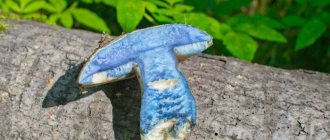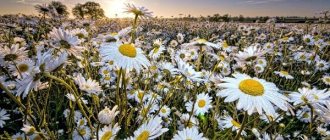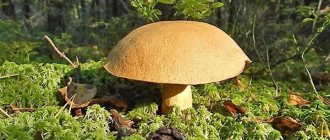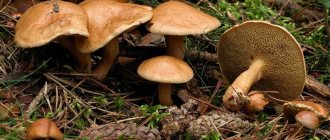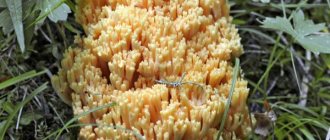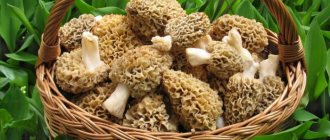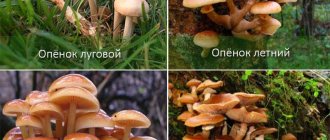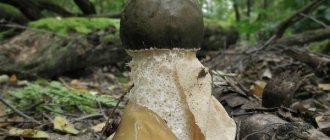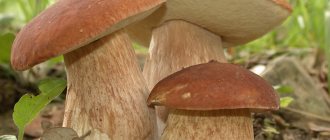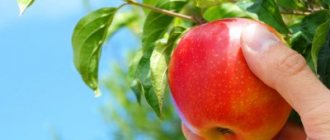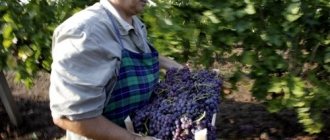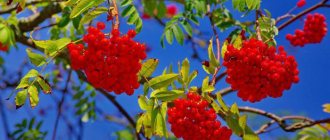Stitches and morels, similar in name and appearance, often cause confusion among novice mushroom pickers. Two early species of mushrooms germinate in forest belts and open areas from mid-spring. They can be detected as early as April. Usually, mushroom pickers go out for the first “silent hunt” by the 20th of April and continue collecting until the air temperature reaches 23-26 degrees. Fruiting of the mycelium lasts on average no more than three weeks.
Which family do they belong to?
Despite the frequent confusion in names, mushrooms can be distinguished not only by name and distinctive features, but also by classification. Strings belong to the genus of marsupials of the Discinaceae family. Morels are edible species of the morel genus, translated in Latin as Phallus esculentus. The unusual name is associated with the shape of the mushroom, visually reminiscent of the outlines of manhood.
Scientific information is, of course, useful, but not very important when collecting. It is much more important for a mushroom picker to find out the differences between morels and strings by studying whether they are edible or not, as well as visual photos of the differences that correspond to the classification of each family. The comparative description presented in the pictures will allow even a beginner to determine the difference when going fishing.
It has been scientifically proven that only morels can be eaten. It is better to avoid the lines in order to avoid poisoning and intoxication of the body. Due to statistics confirming a large number of poisonings, you should not risk your health and the well-being of your family and friends.
Similar species
The autumn line has similarities with a number of related helvels (lobes):
- Curly lobe
It also bears fruit in autumn, the cap has wavy edges and deep folds, the stem is also very ribbed.
- Elastic blade
The fruiting period ends a little earlier. The cap is the same shape, but does not grow to the stem. The stalk is short and often curved.
1-curly blade 2-elastic blade
- pitted lobeweed
It coincides with the species under consideration in terms of fruiting time, but differs in the shape of the stem: it is short, strongly grooved, and consists of fused tubular formations.
- Black lobed
Fruits in the same period. The cap is not saddle-shaped, but saucer-folded. The leg is longitudinally ribbed, pubescent.
1-Lobed pitted 2-Lobed black
The remaining lines and lobes grow in the spring, so it is not possible to confuse the mushroom with them. All of the above species are inedible, like the autumn line itself, or have no particular gastronomic value.
Poisonous or edible?
Morels in Russia, Ukraine and Belarus are used as the main ingredient for various dishes. In the CIS countries and Europe, they are purchased for restaurants, as a gourmet delicacy. Their taste is famous for its unusual nutty aftertaste and is comparable to steamed chicken. Today, morels are classified as edible and conditionally edible mushrooms that germinate in the spring, after the snow melts and the first layers of soil warm up.
Strings are classified as poisonous mushrooms, with the exception of a few varieties that have conditionally edible status. They are consumed after long-term heat treatment, which includes: washing, cleaning from dirt with a brush, repeated boiling and draining of water.
The peculiarity of the lines remains the unique content of poison. It is noted that the more polluted the germination site and the less precipitation, the more poisonous the mushrooms can be. It is not for nothing that in European countries they are classified as prohibited and especially dangerous for consumption even after careful heat treatment. Quite a few cases of poisoning and deaths have been recorded.
The poison of the lines is gyromitrine. Its distinctive feature and main fame is the preservation of the mushroom product in the pulp even after boiling. It doesn’t matter at all how many times the cook boils the lines and changes the water, the poison contained in the pulp will remain.
How to distinguish a morel from a stitch?
Despite the fact that these mushrooms have similar names, they are confused not only in theory. In practice, these two forest inhabitants are very similar to each other, and their fruiting period is similar.
Therefore, it is important for both beginners and experienced mushroom pickers to learn to distinguish between these two forest inhabitants.
In fact, it is worth noting that these mushrooms do not even have common relatives. Thus, lines belong to the family Discinaceae, when morels belong to the morel family.
Morels are safe to eat, but the strings can lead to poisoning, since they are not edible, and in general, they are poisonous in their raw form.
Some types of stitches can be used in cooking, but significant processing must be done first.
There are several signs that allow you to compare these two mushrooms and understand how they differ.
- Morels have an elongated and mostly cone-shaped cap, which from a distance resembles an egg. In the lines, it is shapeless, looks like a turban, and has no created form.
- The morel cap reaches a maximum diameter of 7 cm, but the spherical cap of the stitches can reach a diameter of 13 cm.
- Gently press the mushroom with your fingers. If you are dealing with a morel, you will feel the hollow body. But near the lines it is filled with pulp, which is why it feels elastic to the touch.
- The flesh of these mushrooms is identical in appearance, but the morels give off a pleasant mushroom smell, at a time when the lines do not have the most pleasant aroma.
- The stem of the strings is swollen and short, but the stem of morels is quite long and thin.
- The color of the morel cap is yellow, brown or gray. In the lines, on the contrary, reddish shades predominate.
Based on this knowledge, you will be able to understand what kind of mushroom is in front of you and decide whether to collect it.
There is information on Wikipedia about Morchella.
What is the difference between morels and lines? Photo differences
Distinctive features help to remember not only the names of mushrooms, but also to preserve life after collection. Eating edible fruits and avoiding poisonous ones will allow you to collect a full basket of useful forest harvest, containing a lot of usefulness necessary for the full functioning of internal organs.
There are many charts available online that demonstrate the distinguishing features. In today’s article we will try to evaluate the difference without it, resorting not only to the characteristics of each type, but also to a photo example.
Many novice hunters, having seen the cap of both families, stop wondering what it looks like. In morels, it is more elongated, resembling a cone shape. It has holes, visually comparable to a dried, wrinkled sponge. Stitch caps are more unusual, comparable to oriental headdresses, which have rounded, slightly stretched outlines. Compared to the stem, the cap has a dominant size.
Considering the size of the cap, we can say that both mushrooms do not have a gigantic diameter. However, the size of the morel cap is several times smaller than the lines reaching 20 cm.
The fruiting body of morels is hollow or, one might say, whole. The pulp is snow-white, less often milky, and is fragile. The lines have separate cavities and unevenly growing pulp. When pressed, the mushroom breaks easily.
The stem of morels is white, cream-colored, and belongs to the fine-grained variety. It does not exceed 11-12 cm in height. In circumference, it can reach 6-7 cm. Fully visible on the surface. Grows exclusively on moist surfaces: pine needles, moist soil or moss. The stitches are the opposite; the leg has a short length. Often, the hat practically hides it. It germinates normally on moist soil.
The design on the hat, although similar, is different. The first ones are covered with deep cells that differ in size. The second ones resemble uneven strips connected together. If you look at the mushroom for the first time from afar, the lines will resemble the structure of the brain or the core of a pine nut.
The color scheme of the cap varies. Morels, unlike stitches, can be painted in light tones of yellow and brown, or resemble the shade of wet asphalt. The lines are brighter, often in brown or brown tones.
The aroma of morels is associated with edibility. Mushroom notes are felt both raw and cooked. The lines rather repel use. The aroma of dampness, reminiscent of a swamp, can hardly be tasty and attractive.
Are morel mushrooms healthy: benefits and harms?
Morel Mushroom
Scientists biologists have conducted many studies with morel mushrooms, thanks to which they discovered that such mushrooms contain the substance FD4.
- This is a polysaccharide compound that helps strengthen the eye muscle.
- Currently, many medications have been created that help cope with clouding of the eye lens.
- The substances that make up morels help cleanse the blood and lymph, increase immunity, appetite and the functioning of the gastrointestinal tract.
- The harm of these mushrooms is that they can be confused with poisonous strings - they are very similar in appearance.
In addition, morels have a low calorie content - 16 kcal per 100 grams. But you shouldn’t eat a lot of these mushrooms, as this heavy food may cause indigestion in the intestines.
Varieties of morels with photos, are they poisonous?
Unfortunately, stitches and morels differ not only externally, but also internally. The first ones are strictly forbidden to consume due to the poison content in the pulp, which is dangerous for the body. The latter can and should be used as food after heat treatment. Morel varieties include both edible and conditionally edible species that are acceptable for consumption.
No. 1 - common morel
The classic representative of its species is Morchella esculenta or the common morel. Its distinctive feature for many years has been the merging of the cap with the stem. A single form sets it apart from its peers.
Externally, the cap is ovoid, elongated in shape with cells of varying depths. The leg is light, closer to a snow-white shade, and can reach up to 12 cm in length. The hat is painted in any shade of yellow or brown, from light to dark.
Of the pests encountered during the period of mycelium germination, slugs and other crawling insects hiding in the flesh of the cap become more active. To prevent them from getting into food, after picking, the mushrooms are washed and soaked in salt water for one hour. The procedure gets rid of not only pests, but also dirt that has adhered during the germination period.
No. 2 - conical morel
Morchella conica remains a species of the morel family found in humid areas. The conical shape, combining the cap and the stem, was transferred to the name of the species. The morel is conical and stands out in the area for the following differences:
a hollow but cellular cap with a pointed shape, reaching a length of up to 10 cm, not counting the stem. Usually, the size of the upper part is larger than the lower part. The color scheme is light yellow, with a slight tint of brown. In rare cases, it can be colored to dark brown;
the leg is cylindrical, empty inside. The height is small, in rare cases reaching 6 cm. The diameter does not exceed 1.5 cm. Externally, it is covered with velvet coating and longitudinal grooves. The color scheme is white, less often light yellow.
No. 3 - tall morel
A large morel, similar to a conical one, has the unusual name Morchella elata. Translated into Russian, it is characterized as high. The difference between the species remains the dark shade of the cap and the large, one might even say tall, fruiting body. The length of the “high” reaches up to 35 cm.
The hat resembles a cone, reaching a length of up to 12 cm and a diameter of no more than 2.5. On the top of the mushroom you can see deep cells. The color scheme is red, less often brown with a black tint. The partitions between the cells are expressive, differing in color from the fruit itself. They often have an olive-red tone.
The leg is tall, slightly longer than the cap. It can be an elongated white shape, no more than 16 cm. In adult mushrooms it can be darker, from cream to light coffee shade.
No. 4 - steppe morel
The name speaks for itself! Morchella steppicola, or popularly known as the largest morel (photo below), is found throughout almost the entire territory of Russia. It can be found in April and May on vast steppes, fields, swampy areas and even forest belts where moss sprouts.
The hat is similar in roundness to the stitch, but has a soft creamy tint. It can reach up to 25 cm in width and height.
The leg is snow-white, short and empty. The height in rare cases reaches 2.5 cm.
In order not to confuse the steppe morel with a line that is poisonous or conditionally edible, it is recommended to navigate not only by the signs, but also by a visual photo. With a correct visual assessment of the differences, even a beginner will be able to identify an edible mushroom from a forbidden one that is not recommended for collection.
General description and photo of morels
Depending on whether it belongs to a particular species, the morel has nuances in its external structure. However, there remains a unanimous opinion that this is a very fragile mushroom with a porous body.
Common morel
The cap does not reach more than 8 cm in diameter, most often it is elongated and goes down the stem. The leg reaches a maximum height of 9 cm and a width of 3 cm. It is hollow and has a fragile structure. Closer to the mycelium it expands a little, has a light beige or white tint, less often it is yellow or brown. The cap has a yellow-ocher tint, less often gray, brown, brown or bright yellow. The older he is, the darker his hat.
Most often, the upper part of the mushroom has an ovoid shape, which smoothly turns into a stalk. The surface of the mushroom can be described as cellular, highly porous, moisture accumulates inside or insects live.
The cells in the cap have an irregular shape, mostly round or polygonal. They are not arranged in a strict order, but in a chaotic manner.
If you cut in half you will get to the flesh. It is white, brittle, tender. At the same time, the milky juice and the pulp itself have a very pleasant smell, taste and appearance. The spores of this fungus have an elongated shape, similar to an ellipse. They are smooth, the spore powder has a yellow tint.
The plates are not visible under the bell-shaped cap, which fits tightly to the stem, but rest assured, they are there.
Morchella vulgaris
Varieties of stitches, from conditionally edible to poisonous
Strings, like all mushrooms, have varieties, and most importantly, they differ not only in edibility, but also in external criteria. On the territory of Russia, the following species are most often found:
No. 1 - ordinary stitch
The traditional representative of the species or gyromitra esculenta, quite rarely germinates in the forest belt. Myceliums most often form in open areas rich in sandy soil. Fruiting occurs at the end of March and continues until mid-May.
The hat is medium-sized, reaching no more than 25 cm in width. The shape is round, not quite even, colored in a chestnut shade. Less commonly, it may be dark brown.
The leg is elongated, hidden more than half in the ground. Its height rarely exceeds 10 cm, and its width - 8 cm. It is often flattened, empty from the inside.
The aroma is moderately mushroomy and can confuse the mushroom picker, deceiving his gullibility.
No. 2 - giant line
The large-fruited mushroom, or gyromitra gigas, has an external outline resembling the shape of a brain. The sinuous pattern on the large cap and short stem indicates the conditional edibility of the mushroom.
The hat has an unusual pattern, similar to the kernel of a pine nut. The cavity is empty, uneven, round in shape. Differs in the presence of folds. The color scheme is dirty yellow, less often red. The width can reach 65 cm.
The leg is extremely short, no higher than 4 cm. In a humid environment, it is often hidden in the ground. Color - snow-white. It's always empty inside.
Compared to other varieties, giant stitches can be eaten after prolonged heat treatment. Their pulp contains the minimum amount of gyromitrin permissible for humans after boiling. Of course, not all mushroom pickers agree with this opinion. Experienced mushroom lovers avoid any lines, trying to choose only proven mushrooms that belong to edible species.
You can find a giant line in the spring in the planting of birch trees. Compared to other varieties, its structure is larger, and the cap is light, closer to a yellow tone. The aroma is quite pleasant, reminiscent of lines.
No. 3 - autumn line
Despite its relation to early mushrooms that germinate in spring, gyromitra infula or autumn stitch is popularly considered horn-shaped due to its unusual structure. The mushroom cap resembles the horns of an animal, reaching a length of more than 10-12 cm. There are folds. The color scheme of young mushrooms is light brown, becoming darker with age. The lines that grow in autumn have 2-3 horns, connected together, as if fused. The coating is velvety to the touch, reminiscent of noble fabric.
The length of the leg varies from 4 to 11 cm. The width is no more than 2 cm. The inside of the mushroom is empty and slightly flattened. The color scheme can be white, grayish or light brown. The shape is cylindrical.
When pressed, the mushroom crumbles. The fragile pulp once again proves that the lines are not worth collecting due to their high toxicity. It is preferable to choose conditionally and edible mushrooms that germinate from late June to early September.
Description of morels
Mushrooms have a very memorable appearance. They cannot be confused with other forest species, with the exception of a couple of morel look-alikes.
What they look like
The vast majority of morels are represented by fruiting bodies with clearly defined caps and legs. But there are also less formalized examples.
Mushrooms reach quite large sizes. Their ascomas have a porous structure. Most often, the fruiting bodies are colored in shades of brown.
Despite the name, there are no wrinkles on the surface of these mushrooms. The impression of wrinkling is created by the pronounced pores on the caps of morels. Externally, these pores are very similar to a honeycomb.
Structure and features of the species
Morels are characterized by the following features:
| Characteristic | Description | |
| hat | Form | Round, spherical, ovoid, conical. |
| Surface | Cellular. | |
| Color | Light and dark shades of brown, black, brown. | |
| Size | Diameter and height from 2 to 15 cm. | |
| Leg | Form | Cylindrical, can be expanded towards the bottom. |
| Surface | Furrowed, pitted or scaly. | |
| Color | White, yellow, cream. | |
| Size | Shortened (maximum height is 6 m). | |
| Pulp | Structure | Waxy or elastic. |
| Color | Light. | |
| Degree of fragility | Very brittle. | |
| Taste and aroma | The degree of expression depends on the species. Sometimes qualities are fully revealed only after heat treatment. | |
The fruiting bodies of morels are often hollow. The cap and the leg can be strongly fused or touch each other only at the edge.
Morels, where do they grow in 2021?
Morels can be found not only in forest belts, but also in open areas: fields, meadows, near rivers and swamps, plantings. All varieties get along better in damp areas where moss grows or there is coniferous litter.
Photos in the Moscow region and Leningrad
Often, experienced mushroom pickers go hunting in aspen trees. In Central and Central Russia, their number has increased to the maximum.
The conical morel can be found in pine forests, where both young and old trees grow. Less commonly, the variety can be found in deciduous plantings: birch, aspen, oak groves. Most often, the mycelium takes root in clearings and fields located in the shady zone.
The morel cap loves the sun's rays, appearing later than its fellow tribesmen from the beginning of May. Germination occurs in garden plots, forest paths and even burnt areas. You can meet them after heavy rains.
The gray giant morel is one of the most unpretentious. It can grow in any area, regardless of the climatic characteristics of the region, weather and soil. Most often found near poplars.
To detect morels, you should remember the necessary germination conditions:
- a sufficient amount of moisture remaining in the first months of spring, as well as near rivers and swamps;
- germination occurs from April to May, until the air temperature exceeds 23-25 degrees during the daytime;
- fruiting lasts no more than 3 weeks;
- It is better to look for a good harvest after rain in a deciduous or mixed forest.
Important!
The morel mushroom bears fruit for a short time. All mushroom pickers know that it can only be detected between April and May, while the upper layers of the soil are saturated with melt water. As soon as the soil dries out, the forest harvest disappears. Fruiting occurs once a year.
Despite the short fruiting period, the yield can reach maximum levels. If warm but rainy weather comes to the region, you can collect baskets full of mushrooms. The small size of morels will allow you to prepare both first and second courses, preparations for the winter and even freezing for winter use.
Why don't many mushroom pickers collect morels? The answer lies in its repulsive appearance. In comparison with porcini, Polish mushrooms and obabkas, morels do not attract attention from the outside, and sometimes even seem foreign.
It is impossible to confuse edible morels with dangerous stitches! Differences in appearance are fundamental criteria in distinguishing two different families. The video below demonstrates the distinctive features:
Types of morels
The morel is a very popular mushroom, and there are dozens of its species. Let's get acquainted with the most popular ones.
Bohemian morel cap
The cap of this mushroom reaches 4 cm in diameter, has a bell-shaped appearance, less often thimble-shaped.
Young mushrooms are distinguished by the fact that their cap edges fit tightly to the stem. The older you are, the farther the edges of the cap extend from the stem.
The color is predominantly brown, sometimes brown or even gray. The surface is wrinkled, covered with tortuous folds that branch in all directions.
If you touch the cap at the very bottom, you can see how smooth it is and even has a different shade. It contains a large number of white veins.
When cut, the flesh of the mushroom is light. It is very brittle and fragile, so mushrooms must be transported carefully. The smell of dampness predominates.
The leg reaches a height of 15 cm maximum, with a diameter of no more than 3 cm. It is quite long, has a cylindrical shape and is slightly curved to the right or left. Therefore, the mushroom can hardly bear the cap. Most often it has a white or beige tint, but with age it acquires dark spots.
This fungus prefers deciduous or mixed moist forests for its distribution. It is ideal if birch, linden, aspen, and other trees, concentrated in large groups, grow there. The mushroom prefers to settle along swamps, streams and ponds.
During fruiting from mid-April to the end of May - beginning of June, depending on the onset of cold weather. On the territory of the Russian Federation it prefers abundant forest zones for habitat.
The mushroom belongs to the category of delicacies and can be consumed both dried and fresh. However, pre-treatment is advisable. The mushroom is rarely served salted or pickled.
Conical morel cap
This mushroom is completely unremarkable due to its small size.
The cap reaches a maximum diameter of only 4 cm, which is very small compared to the stem. It has a bell-shaped conical shape, and its entire surface is covered with not deep wrinkles.
The hat is very smooth, but slightly wrinkled, with a small number of bumps and brown inclusions.
The inner surface of the cap is light brown. The edge itself is free and has a pronounced edge. The outermost part of the cap is light, incredibly fragile, waxy and slightly thin, so the mushroom is very easy to deform. It has a pronounced damp taste and a similar smell.
The leg reaches a width of 2 or 3 cm, so the cap on it looks very small. It reaches a height of 20 cm.
It has a cylindrical shape, but the closer to the mycelium, the more it bends from the sides. The leg is solid, however, over time it becomes brittle. It has a creamy white or white-yellow tint, more often it is yellowish or yellow-beige, and has a fine powdery coating.
The mushroom lives in mixed and deciduous forests, which have a high percentage of dampness. Loves river valleys, where it grows in abundance.
Prefers to grow in the shade of willows, birches and aspens.
It bears fruit in the same way as its predecessors from April to May. Loves temperate forest zones in the central part of the Russian Federation. It belongs to the category of delicacies and can be consumed fresh or dried. Can be pickled and salted.
Tall conical morel
Another bright representative of the morel family that you definitely cannot pass by. A very fancy mushroom, the cap of which is only 3 cm in diameter, but extends down the stem to 10 cm. It has an elongated conical shape of a gray tint, less often gray-green. Along the edges it grows together with the stalk, and its surface is cellular-ribbed, with elongated cells that are separated from each other. The partitions are painted in dark shades.
In the cross section you can see how the pulp behaves. It is waxy, white, brittle, and has no particular taste or even smell. In this case, the fruiting body develops quite slowly, but remains fresh for a long time.
The volume of the leg reaches 3 cm, but the height does not exceed 5 cm. It has a white tint, less often yellowish or beige. The older the mushroom is, the more brown it is.
It lives in forests of various types, with predominantly humus soil. It often begins to grow in places where forest fires have burned. Prefers places with abundant moss, forest edges, as well as areas located along roads and ditches. It does not like swamps, because with too much water it begins to rot.
Distributed throughout the entire zone of the Russian Federation, avoiding the northern regions and southern regions.
It bears fruit from the end of March until the very beginning of June.
The mushroom is considered edible, however, before consuming it is worth boiling it for a short time in order to get rid of the negative substances in the composition. Most often used for preparing fillings, appetizers, and main courses. Ideal for freezing and later use.
Has good medicinal properties. For example, substances were found in this mushroom that are aimed at strengthening the muscles of the face, including the eyes. Eating morels helps slow down the process of clouding of the eye lens.
Also, today in pharmacies you can find the drug “Smorchok”, which actively fights eye diseases, including such serious ones as cataracts.
Morels contain an ethanol extract, which has a pronounced bactericidal property. Has a positive effect on the suppression of bacteria, such as Staphylococcus aureus.
Is an ideal candidate, also an anti-inflammatory agent.
In China, a similar mushroom is widely used mainly to increase vital energy, as well as to combat diseases of the gastrointestinal tract.
Morel powder is used to treat joints, arthritis and other diseases. It is used not only in powder form, but also together with a decoction of medicinal herbs.
Morel spongy
The cap of this mushroom reaches a maximum diameter of 6 cm. It is quite small, but in comparison with other representatives of this type of mushroom it is round and has the shape of a hemisphere. Most often, this mushroom is found in a yellowish or brown tint, less often - red or gray. The cap merges smoothly with the leg. If you look at the surface of the cap, you can see a lot of different cells in shape and external structure.
The mushroom has thin edges and they are located chaotically.
When cut, the pulp of the mushroom has a waxy structure, is brittle, and has a pleasant mushroom aroma. The mushroom itself is quite small and easily fits in the palm of your hand. Has a large amount of milky juice.
The leg reaches 4 cm in height and 1.5 cm in volume. It is hollow and cylindrical.
It lives mainly on sandy soil, in places where there is bright sun and lack of moisture. Fruits from late April to mid-June. Distributed throughout central Russia and in the northern forest zone, and is also found on coasts and sandy plains. An edible and very tasty mushroom, which is consumed fresh and at the same time dried.
Delicious morel
A mushroom whose cap reaches a diameter of 5 cm, and in height it descends along the stem to 10 cm. It has a wide conical shape and is rounded towards the base. The shade of the cap is very interesting, as it is green, almost emerald, and in contrast with the fused white stem it looks very attractive.
The surface of the mushroom, like that of other representatives of the species, is ribbed and cellular, with elongated diamond-shaped cells.
The pulp is waxy, whitish and brittle, odorless and tasteless when raw.
The stem of this mushroom is short, mainly because the cap absorbs most of it. Reaches 4 cm in length and 2 cm in width. It is yellow or white, hollow, and has a creamy tint.
It lives preferably in deciduous and coniferous forests, found in gardens and parks, on the edges of forests, in clearings and along roads. Sometimes mixed colonies can form, where conical morels are also present.
It bears fruit from late March or early April until mid-summer. However, this is only possible in the case of a warm spring.
Distributed throughout the Russian Federation, with the exception of the Far North. This mushroom is edible, early, summer, tasty, consumed in any form, including fresh.
Morel semi-free
Another mushroom from the morel family that will delight you with its taste properties.
Like other representatives of the species, the cap is not branched, descends along the stem to a length of up to 4 cm, with a diameter of about 3 cm. Color variations of the cap can be different, from light olive shades to dark brown tones.
The stem is crystal white, however, the older the mushroom is, the more yellowish it becomes. The vertical folds have dark brown shades, the tip of the cap is quite thin and sharp. The hat fits tightly to the leg, and its edges are free.
The leg reaches 12 cm in height and 3 cm in width. It is hollow, cream and white in color. It can be described as fine granular, slightly expanding closer to the mycelium.
This mushroom lives in light deciduous forests, less often prefers mixed ones. Can be found in birch groves, gardens and parks. Predominant in clearings and forest edges. Prefers forests of birch, aspen, oak, linden, and so on. Sometimes found among tall shrubs and grasses.
It bears fruit from April to the very end of June. Distributed throughout Russia in the middle and southern zones. But he diligently avoids the northern ones. The mushroom is edible and tasty, consumed fresh or dried.
Garden morel
The hat reaches 7 cm in diameter and 5 cm in height. Brown, less often grayish-brown or light. An olive tint is even less common.
The edge of the cap tapers and fits tightly to the stem. The entire cap is covered with small, irregularly shaped cells located randomly.
The pulp is white, waxy, and has a pleasant mushroom smell and taste. Very similar to champignons.
The stem of the mushroom is quite short, does not exceed 5 cm in length and 2 cm in girth. It is creamy, hollow, cylindrical and white. Inhabits forests of various types, preferring humus soils.
Fruits from April to mid-June. It has spread throughout the forest zone of the Russian Federation, avoiding the territory of the Far North. The mushroom is an edible, tasty spring mushroom.
Edible morel
This is probably the most popular mushroom from the morel family. Its popularity is due to the fact that it is found most often, and it tastes one of the most pleasant.
The cap of this mushroom is memorable; seeing it once, it is impossible to forget. It reaches about 8 cm in height, another 8 centimeters in cross section. The color is most often yellow-ocher, less often yellow-brown or brown. The darker the color, the older the mushroom. The shape is ovoid, round, hollow, fused with the stem very tightly.
The cells are located randomly. The pulp is waxy, tender, brittle and white, has a pleasant taste and smell. Leg height 9 cm, girth 3 cm. One is cylindrical and hollow, slightly widens towards the bottom, yellowish-brown. Has longitudinal grooves at the base.
Lives in forests of various types, loves humus soils. Most often they settle in places where forest fires were burning and on the edges of forests.
Fruits from April to early June. If the months are cold, it may bear fruit until the middle or even the end of the month.
If the autumn turned out to be warm, perhaps the second layer of morels of this type grows. Distributed throughout the forest zone of the Russian Federation, avoiding the regions of the Far North.
Thick-legged morel
The cap reaches 12 cm in height and 10 cm in cross section. The color shades of the cap of this mushroom are the most incredible, ranging from brown and olive shades to bright red flowers. In many ways, it all depends on the composition of the soil.
The cap does not have a clear ovoid or oval shape; it seems to be located at the wrong angle, hanging slightly from the stem.
The edges of the cells of the cap have a reddish tint. However, the waxy, tender, white flesh of the mushroom has a pleasant taste and smell.
The leg reaches a length of 20 cm, a width of 4 to 8 cm. Despite its thickness, it is hollow, but thickens towards the upper and lower parts.
Heterogeneous, hilly, folded, has uneven longitudinal grooves. The leg is quite brittle, has dark cream shades, interspersed with red and brown spots.
The mushroom prefers to live in mixed and deciduous forests, and also loves mountainous areas.
Prefers forests where ash, hornbeam, poplar, maple, and linden grow. It can also be found in orchards, as well as in burnt areas. Fruits from April to the very beginning of June.
Distributed throughout the Russian Federation in the forest-steppe and mid-steppe zones. Also suitable for growing in mountain forests and foothills, where the soil is rich in nutrients and moss.
The mushroom is edible and can be consumed fresh or dried.
Despite the fact that morels are edible mushrooms, we still must not forget about the safety rules. Mushrooms must undergo high-quality processing before they appear on your table.
You can cook absolutely any dish with morels. They are excellent in stewing, boiling and frying. They can be dried and used as spices. They will add piquancy to any dish. Or you can use it fresh, just lightly fry it in a frying pan.
However, it is still recommended to approach the issue of using morels more carefully. It is important to prepare it correctly before use, then you will only have the most pleasant impressions. Especially if children intend to eat the morel dish.
- So, first, the mushrooms need to be cleared of forest debris. Remove needles, pieces of soil, grass, plants, sticks, branches and insects.
- Rinse the morels well under cold running water. Be careful, mushrooms are very fragile and one careless movement of your hand can simply break them.
- You can leave washed morels in cold water for 30-40 minutes. This measure is necessary to ensure that the mushrooms release all the dust that has crept into their cells.
- Then place the mushrooms on cheesecloth, blot them well and wait until they are completely dry.
- If you intend to cook dishes with morels, put water on the fire and bring to a boil. Add mushrooms to it and boil for 10 minutes. This time is quite enough to rid the mushrooms of harmful substances.
- If you intend to heat treat the morel, for example, dry it, then you can immediately cut the mushrooms into longitudinal pieces and place them on baking paper.
Boiled mushrooms can be used in preparing salads, appetizers, first and second courses.
Do not forget about the similarity of the morel to the stitch, an inedible mushroom that can cause poisoning.
The morel is a unique mushroom that you can easily find in the spring. All you have to do is look carefully at your step, because these mushrooms are masters of camouflage.
But once you try them, you won’t be able to deny yourself the pleasure of putting together a whole basket.
Lines where to grow in 2021?
Years go by, but the gathering places do not change. Like morels, stitches can be found in almost any forested area, plantings of birch and aspens, open fields and meadows. Less commonly, mushrooms are found near swamps and rivers, where water nourishes the soil, maintaining high humidity for several weeks longer.
In Crimea and Kuban
Like morels, morels sprout in different places, depending on the variety. Some prefer pine forests, coniferous plantings and clearings. This applies in particular to the giant line. But the “autumn” one prefers deciduous and mixed zones, open areas adjacent to the river mouth.
Where, in what forest and when can you pick morel mushrooms?
Morels
Morel mushrooms appear only on soils favorable for their growth, namely:
- In coniferous and mixed forest plantations and forests, on the edges, along roads, clearings
- In garden plots
- On the ground after fires
- In parks and gardens
Morels grow equally well in fertile soils as well as in sandy and sandy loam soils. Finding such a mushroom is not easy, as its cap blends in with the color of last year’s foliage and dry grass. These mushrooms are collected in April-May.
Morels and lines, taste
Two separate families with similar names differ in appearance and have different aroma. However, the taste of the products is similar. Refined soft mushroom pulp is not comparable to the popular honey mushrooms and even noble mushrooms. In Europe, morel fruits are used as a delicious ingredient for preparing various dishes. Just like truffles, their taste and aroma are valued by gourmets.
Morels are used to prepare various dishes. However, the most popular remain fried mushrooms with onions and meat fillet, as well as stews in sour cream sauce.
The lines are no less tasty, but quite dangerous. In Germany, their collection is strictly prohibited! Numerous poisonings warn of detrimental harm to the body, both adults and teenage children over 14 years of age. Even conditionally edible varieties may not always be beneficial if you ignore the rules of heat treatment or collect the fruits in a contaminated place.
Useful properties and restrictions on the use of morels
The fruit contains a large number of natural beneficial substances:
- protein (makes up almost 25% of the fruiting body);
- amino acids;
- B vitamins.
The consumption of such mushrooms and products prepared from them has a positive effect on the gastrointestinal tract, relieves inflammatory processes in the body and contributes to the body’s resistance to various diseases. In Russian folk medicine, decoctions of conical morels were used to improve vision.
Morels and products prepared from them should not be consumed:
- children under 12 years old;
- pregnant women;
- nursing mothers.
Note!
Improper preparation and consumption of old fruits can lead to poisoning, jaundice and an imbalance of red blood cells in the blood.
Cooking morels and strings, recipes for heat treatment at home
The recipes of the two families are different. Some do not require long-term heat treatment before preparing the dish you like at home, while others, on the contrary, without double boiling, become no less dangerous than their poisonous counterparts. For proper preparation, in addition to the recipe, in the preparation of stitches, it is recommended not to forget about the rules of heat treatment: including:
- the washing up;
- soaking in salted water;
- boiling carried out repeatedly, with the broth drained.
Morels must be soaked in salt water for one to two hours. Such manipulation rids the fruit of contamination and slugs hiding inside the hat. Upon completion, the mushrooms are boiled, adding onion rings to the water to give the fruits a bright aroma. As soon as the heat treatment is complete, begin preparing the dish you like:
- morels with sour cream and onions;
- morels with cream according to the technological map;
- salted morels recipe;
- with potatoes fried in a frying pan;
- morels with eggs and pasta;
- recipes with meat;
- recipe from Yulia Vysotskaya;
- preparation for the winter: fried in jars, pickled and salted.
Lines used for consumption are only conditionally edible. Poisonous fruits are avoided due to the toxicity that persists even after heat treatment. After washing, soaking and repeated boiling, the water is drained each time and the preparation of the main dish begins. Most often it is preserved for the winter, less often - a second course.
The most popular recipes with lines:
- with potato;
- with sour cream;
- with cream;
- preparation for the winter, salted or fried.
How to dry morels
Fresh morels are quite fragile and may crumble during handling, peeling and cooking. Dried morels are easier to handle. They soak quickly, do not crumble, and are much easier to stuff.
Drying is an art. All you need is time, air flow and heat. If the weather remains warm and sunny for a long time, you can dry the mushrooms naturally: you should place the morels on the surface in a well-ventilated place and turn them over periodically.
Important! As the product dries naturally, it absorbs additional vitamin D from the sun and then has a wonderful aroma when finished.
Morel propagation
Morels reproduce asexually or sexually.
- The asexual method includes reproduction by parts of the mycelium (mushroom body) or conidia (immobile spores).
- Sexual reproduction is carried out with the help of ascospores (cells with half the set of chromosomes), which mature in bags (asci). Bags in fungi are formed in fruiting bodies (apothecia), the formation of which is preceded by a sexual process called somatogamy. In this case, the vegetative hyphae of different individuals merge.
Morels are not lamellar or tubular mushrooms. Their hymenophore is smooth. The spore-bearing layer (hymen) is located along the bottom and slopes of the ribs and consists of bags with 8 ascospores. The asci are large, cylindrical, rounded at the apex. Ascospores are ellipsoidal or spherical, with an uneven surface or smooth, arranged in one row, multinucleated at maturity. Morel spores may be colorless or slightly yellowish. They can be seen under an electron microscope. The release of spores is regulated by solar radiation and occurs gradually.
The life cycle of morels begins with the germination of multinucleate ascospores. The seedling gives rise to a primary haploid multinucleate mycelium, which exists for a very short time. Ascospores are able to germinate even after long dormancy or storage, after 4-5 years. The hyphae of the primary mycelium of the morel form anastomoses (the connection of two hyphae of one mycelium) or merge with the hyphae of another primary mycelium. As a result of the fusion, a diploid multinucleate organism appears. Subsequently, it is able to enter into symbiosis with higher plants, forming conidial sporulation or sclerotia (dormant stages). The main reason for the formation of sclerotia is a deficiency of nutrients in the soil. The life cycle of morels is dominated by the asexual (vegetative) stage.
Photo credit: Jason Hollinger, CC BY 2.0
Morel poisoning: symptoms and first aid
Old, raw and improperly prepared morels can cause poisoning. Symptoms of toxicosis begin to appear approximately 6 hours after eating mushrooms. First appear:
- stomach pain,
- nausea,
- vomiting bile,
- cardiopalmus,
- diarrhea,
- headache.
Depending on the age and health of the affected person, morel poisoning may be more severe or easier to bear. Further spread of the poison throughout the body leads to the destruction of red blood cells and, as a result:
- to weakness,
- drowsiness,
- dizziness,
- paleness of the skin.
If after this no help is provided, then after a day the poison of morels will provoke the destruction of liver cells, damage to the kidneys and urinary tract. There will be discomfort during urination.
The third stage is the effect of toxins on the nervous system:
- a poisoned person becomes inadequate,
- he experiences convulsions, hallucinations,
- he may fall into a coma.
Mushroom poisoning can last from a day to 2 weeks, depending on the state of the person’s immune system. Morels contain a large amount of bilirubin, so poisoning may additionally be accompanied by yellowing of the skin.
There is no antidote against morel toxin, and the poison must be removed from the body mechanically. In this case, the following procedures will help:
- gastric lavage,
- cleansing enemas,
- taking activated carbon or other sorbent,
- drinking large amounts of warm liquid,
- and you definitely need to call a doctor so that he can continue the necessary treatment.
Photo credit: Morel dish photo, CC BY-SA 3.0
